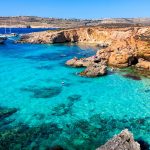Male’s fish market is buzzing.
The Indian Ocean harvest is plentiful.
Wholesalers haggle hard, fighting to get the best price for the catch.
The cacophony is matched by the riot of colour provided by the glassy-eyed fish.
There is always enough to provide for the islanders and to support a thriving export industry.
Next door is the capital’s fruit and vegetable market. Small yellow bananas hang on their stalks over stalls full of green mangoes, small red chillis and plump cabbages.
But in the Maldives, land to grow fruit and vegetables is limited.
COP26 opens for business
COP26: Day one of the United Nations climate summit shows how difficult negotiations will be
Fishing row: British scallop trawler released as France backs down on immediate threats in fishing feud
That is why crops like these are valuable and valued.
The changing seasons are making it more difficult to grow cash crops.
Violent storms that have lashed the northern islands have wiped out an entire season’s growth.
Mohamed Adam has struggled.
He owns a small farm in Dhigurah, a small island south of Male.
His farm is close to the shoreline and that brings risk. Storm surges are more frequent.
They drench his crops in salt water, damaging and sometimes killing his crops, including his beloved banana trees.
Mr Adam tells me: “The bad weather lasts much longer and the frequency of storms is much higher now.
“With the calm periods being a lot shorter, the crops do not have a chance to recover and grow again before another storm hits.”
The extreme weather Mr Adam describes is driven by climate change, and it is threatening to destroy the Maldives, killing its coral reefs and submerging the islands.
The Maldivians – on their own – are powerless to stop this.
But they are doing what they can to protect their country.
Thilafushi is better known as trash island. It is a festering mountain of waste that rises out of the pristine emerald water.
HeyGiant dumper trucks blow sandstorms as they carry their waste up the steep hill of rubbish.
Up to 700 tonnes of domestic waste were dumped here every day and burned in the open, belching toxic fumes into the atmosphere.
Local islanders nearby complained of being permanently shrouded in smoke.
After 30 years, the fire is finally out.
A modern waste plant with a closed incinerator producing green energy will be built here instead.
Please use Chrome browser for a more accessible video player
Imjad Jaleel, a waste-to-energy project consultant for the new site, says the Maldives government is determined to minimise the environmental impact on the islands.
He said: “I think what we are doing is what has to be done as a responsible nation, as a responsible government, as a responsible country with citizens who are dying to breathe in fresh air.
“I personally couldn’t have imagined that I would be standing in the middle of this volcanic landfill and still be breathing clean air.”
Maldivians understand the climate threat facing their nation.
For years, they have been asking the world for help. But the iconic coral-fringed islands do not look like they are facing an existential threat.
The calm turquoise waters and golden palm-fringed beaches are too easily associated with the islands’ five-star resorts.
Please use Chrome browser for a more accessible video player
It is easy to overlook the 400,000 people who have lived on these islands for generations. It is their home.
There is already talk of relocating vulnerable coastal communities.
If that happens, more than lives and livelihoods will be lost.
Follow the Daily podcast on Apple Podcasts, Google Podcasts, Spotify, Spreaker
For full coverage of COP26, watch Climate Live on Sky channel 525.
Follow live coverage on web and app with our dedicated live blog.
Get all the latest stories, special reports and in depth analysis at skynews.com/cop26






















